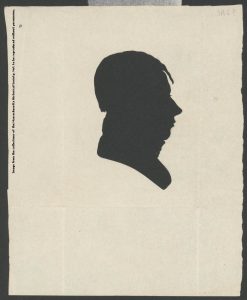By Neal Millikan, Series Editor for Digital Editions, The Adams Papers
Transcriptions of more than 2,500 pages of John Quincy Adams’s diary have just been added to the John Quincy Adams Digital Diary, a born-digital edition of the Adams Papers editorial project at the Massachusetts Historical Society. The new material spans the period January 1830 through December 1838 and chronicle Adams’s experiences serving in the United States House of Representatives.
John Quincy Adams left the presidency on 4 March 1829 believing that his tenure in public service had ended, yet uncertain how to fill his days. When on 17 September 1830 congressman Edward Everett approached Adams to see if he would again stand for office, the statesman was unsure how to respond. He recorded in his diary: “To say that I would accept, would be so near to asking for a vote, that I did not feel disposed to go so far— I wished the People to act spontaneously; at their own discretion.” Upon learning of his congressional election, Adams commented that “My Election as President of the United States was not half so gratifying to my inmost Soul— No election or appointment conferred upon me ever gave me so much pleasure.”

Adams took his seat in the House of Representatives in December 1831, representing the Plymouth district of Massachusetts in the 22d Congress. During his first years of service in that legislative body, Adams became chairman of the Committee on Manufactures, helping to compose the compromise tariff bill of 1832. He was also involved in the rechartering of the Bank of the United States, producing a minority report in support of the bank after traveling to Philadelphia as part of a House committee to inquire into its affairs. And he became increasingly interested in the Anti-Masonic political party, unsuccessfully standing as their Massachusetts gubernatorial candidate in 1833.
Adams subsequently served in the 23d through 25th Congresses, and it was during this period that he gained the sobriquet “Old Man Eloquent” for the speeches he gave against slavery and the annexation of Texas. He regularly presented antislavery petitions that he received from across the nation. When the House voted to pass a Gag Rule in May 1836 that would table all petitions relating to slavery, he was outraged: “On my name’s being called . . . I answered I hold the Resolution to be a direct violation of the Constitution of the United States—of the Rules of this House and of the rights of my Constituents.” Although the Gag Rule passed, Adams continued to present the antislavery petitions he received. His actions led southern congressmen in 1837 to draft a resolution of censure against him, the vote of which failed. Adams noted in his diary that his defense of the right of petition at that time so consumed him that it was “The first time for more than forty years” that he had “suffered a total breach in my Diary for several weeks— At one of the most trying periods of my life.”
The other national issue that consumed John Quincy Adams during these years was protecting Englishman James Smithson’s $500,000 bequest to the United States. Adams chaired the House committee that created a bill stating that the national government would apply the bequest to the founding and endowment of the Smithsonian Institution at Washington, D.C. He marveled that a foreigner should provide the means to found in America “an establishment for the increase and diffusion of knowledge among men,” and he believed that this was “an event in which I see the finger of Providence compassing great results by incomprehensible means.”

John Quincy Adams lost two close members of his family during these years: his brother Thomas Boylston Adams died on 13 March 1832, and his middle son John Adams 2d passed away on 23 October 1834. After his son’s death, Adams found himself, “In a state between stupefaction, and a nervous irritation aggravated by the exertion to suppress it.” He became the legal guardian of his son’s two daughters, Mary Louisa Adams and Georgeanna Frances Adams, and his pecuniary duties toward his brother’s and son’s widows and children created significant financial responsibility for the congressman.
He and his wife Louisa Catherine Adams welcomed five new grandchildren into their family during this period, bringing the total to six. In his free time, he continued to walk, swim, and garden. He also found time to compose the 2,000-line poem “Dermot MacMorrogh, or The Conquest of Ireland,” which met with lukewarm reception from reviewers. As he entered his seventies, John Quincy Adams came to increasingly rely on his only surviving child, Charles Francis Adams, for financial and familial advice. “All my hopes of futurity in this world are now centered upon him,” Adams wrote.
For more on John Quincy Adams’s life, read the headnotes for the 1830–1834 and the 1835–1838 periods, or, navigate to the entries to begin reading his diary. The addition of material for the 1830–1838 period joins existing transcriptions of Adams’s diary for his legal, political, and diplomatic careers (1789–1817), his time as secretary of state (1817–1825), and his presidency (1825–1829), and brings the total number of transcriptions freely available on the MHS website to more than 8,300 pages.
The Adams Papers editorial project at the Massachusetts Historical Society gratefully acknowledges the generous support of our sponsors. Major funding for the John Quincy Adams Digital Diary was provided by the Amelia Peabody Charitable Fund, with additional contributions by Harvard University Press and a number of private donors. The Andrew W. Mellon Foundation in partnership with the National Historical Publications and Records Commission also support the project through funding for the Society’s Primary Source Cooperative.

